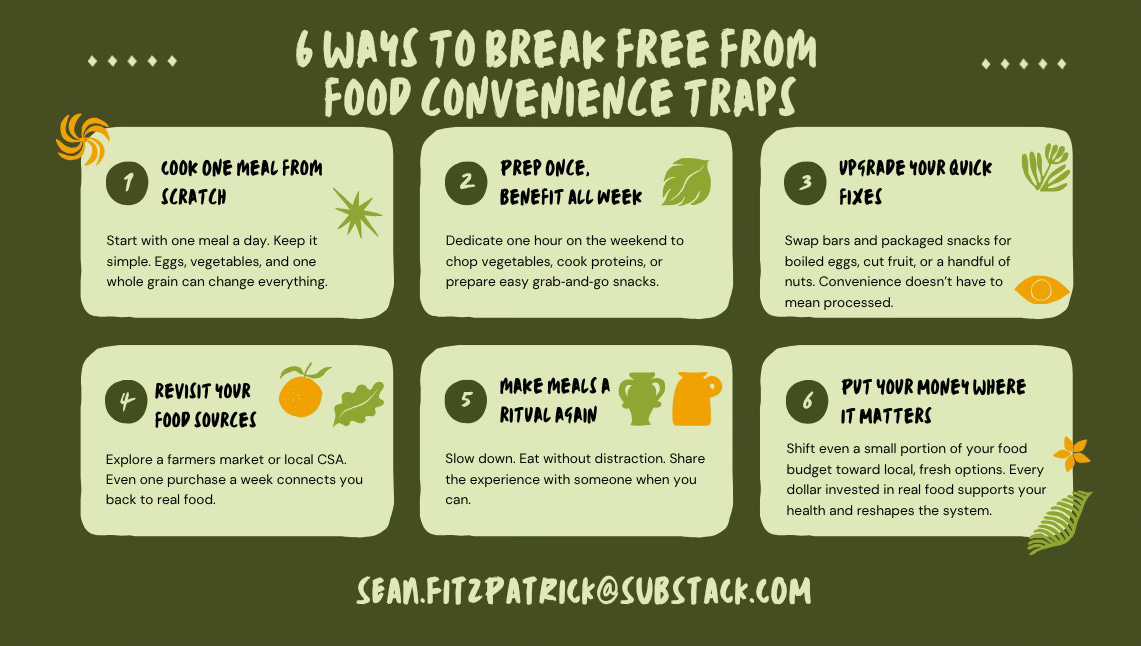The Cost of Convenience: What Are We Trading, and Is There a Way Back?
Convenience isn’t going away, but how we respond to it can shape the future of food.
Convenience isn’t going away. In fact, it’s evolving faster than we can process. And in many ways, it’s made life easier, safer, and more connected.
But when it comes to food — real food — convenience comes at a cost that’s easy to ignore and hard to calculate.
We’ve been conditioned to treat time as the most valuable currency. So when something makes life faster or simpler, it feels like a win. But what are we actually giving up in the process?
We lose the ritual of preparing food.
We lose the depth that comes from knowing where our food comes from.
We lose the relationship with the people who grow it.
We lose the strength of our communities that once shared and supported one another with local, seasonal food.
And most dangerously, we lose our tolerance for any kind of inconvenience.
The Addiction We Don't Talk About
Our addiction to sugar, ultra-processed ingredients, and engineered foods is real. But our addiction to convenience might be even stronger.
Not because we’re lazy. But because we’re stretched, distracted, and overwhelmed. And because we’ve been sold the story that real food is just too hard.
A generation and a half ago, local food wasn’t a movement. It was just food. It was organic by default, seasonal by necessity, and shared among families, neighbors, and communities. Now, "eating local" can feel like a boutique lifestyle or a luxury for people with time to spare.
Going to a farmers market, finding a nearby farm stand, or cooking a meal from scratch — these things now feel inconvenient. And that should stop us in our tracks.
So What Do We Do?
We don’t beat ourselves up. We don’t throw away our schedules or pretend we can opt out of the modern world. But we can build awareness.
And from that awareness, we make a shift…even if it’s a small one.
Maybe it’s committing to one weekly meal sourced from your local food system.
Maybe it’s carving out time to meet your farmer, ask where your food comes from, or invest in a CSA.
Maybe it’s choosing the slightly less convenient option because it aligns with your values.
And maybe it’s asking harder questions like:
What would it take for local food to become more accessible, without losing its integrity?
How do we help small and mid-sized farmers access regional markets?
How much of a town’s or state’s budget needs to support local food for small farms to survive?
What role do certifications, safety protocols, and food hubs play in scaling up
What does a thriving local food economy actually require from us?
These questions are not hypothetical. They are the key to keeping real food alive for the next generation.
Building Toward a New Kind of Convenience
If we want local food to be more accessible, we need more than just farmers. We need food hubs, online marketplaces, better logistics, and real community investment. We need systems that reward transparency, trust, and nutrition — not just shelf life and volume.
We also need to recognize that every dollar we spend shapes the system we live in. Even a small shift in our food budget toward local options creates a ripple. It signals that convenience shouldn’t be the only thing that matters.
Convenience isn’t the enemy. But unexamined convenience is.
This isn’t about guilt. It’s about alignment. About reclaiming a piece of your food system and helping ensure there’s still a future for local food that doesn’t feel so far out of reach.
This is where personal practice meets collective power.
And it starts with one simple question.
What’s one thing I can trade back today?


